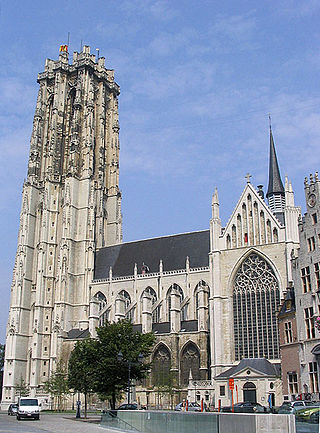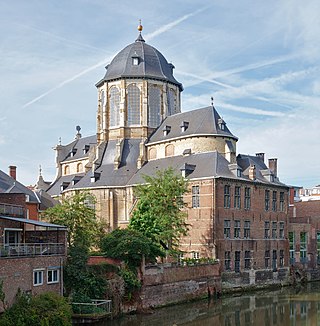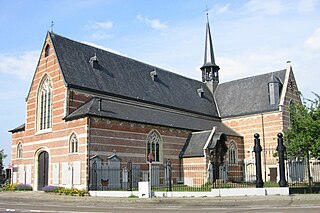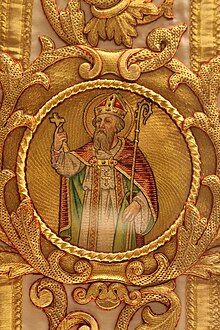
Mechelen is a city and municipality in the province of Antwerp in the Flemish Region of Belgium. The municipality comprises the city of Mechelen proper, some quarters at its outskirts, the hamlets of Nekkerspoel (adjacent) and Battel, as well as the villages of Walem, Heffen, Leest, Hombeek, and Muizen. The river Dyle (Dijle) flows through the city, hence it is often referred to as the Dijlestad.

St. Rumbold's Cathedral is the Roman Catholic metropolitan archiepiscopal cathedral in Mechelen, Belgium, dedicated to Saint Rumbold, Christian missionary and martyr who founded an abbey nearby. His remains are rumoured to be buried inside the cathedral. State-of-the-art examination of the relics honoured as Saint Rumbold's and kept in a shrine in the retro-choir, showed a life span of about 40 years and a death date between 580 and 655, while tradition had claimed 775 AD.

John Berchmans, SJ was a Jesuit scholastic and is revered as a saint in the Catholic Church.

The Cathedral of St. Michael and St. Gudula, usually shortened to the Cathedral of St. Gudula or St. Gudula by locals, is a medieval Roman Catholic cathedral in central Brussels, Belgium. It is dedicated to Saint Michael and Saint Gudula, the patron saints of the City of Brussels, and is considered to be one of the finest examples of Brabantine Gothic architecture.

Rumbold or Rumwold was a medieval infant saint in England, said to have lived for three days in 662. He is said to have been full of Christian piety despite his young age, and able to speak from the moment of his birth, professing his faith, requesting baptism, and delivering a sermon prior to his early death. Several churches were dedicated to him, of which at least four survive, one being at Pentridge in Dorset.

June 23 - Eastern Orthodox Church calendar - June 25
Keldermans is a family of artists, originating from Mechelen. The members of the family were mostly architects working in the Brabantine Gothic style. As the most important architects of their time in the Netherlands, they defined the Brabantine Gothic style, and their works can still be seen today in cities like Mechelen, Brussels, Antwerp, Ghent, Lier, Middelburg and Gouda. Anthonis II and Rombout II were court architects for Charles V. Laurens II, last in the line, was influenced by Renaissance architecture and marked the end of the Gothic period in this region. The Keldermans family became known for the design and construction of the large tower of St Rumbold's Cathedral in Mechelen. Jan II qualifies most as the designer, the architect and the most important master builder. However, he would not see the start of the works himself and the first stone was therefore laid under the supervision of his son Andries. Other members of the Keldermans family who successively directed the works are Anthonis I, Anthonis II, Rombout II and Laurens II.
Rombout is a Dutch masculine given name, equivalent to English Rumbold. It is of Germanic origin, containing the Old Saxon elements -hrôm- and -bald- ("brave"). It is also possible that the first element comes from -Rûma- ("Rome"), a place name that also featured in old Germanic names. Early source usually Latinized Saint Rombout's name as Rumoldus, as in the first known mention in a pre-927 grant by Charles the Simple, mentioning that the Mechelen abbey had been built in his honor.

Saint Gummarus of Lier is a Belgian saint. He was the son of the Lord of Emblem. An official in the court of his relative Pepin the Younger or Pepin of Herstal according to some other sources, after a number of years in military service he retired to live the life of a hermit. The town of Lier grew up around his hermitage.

St. Catherine's Cathedral, Utrecht, is a Catholic church dedicated to Saint Catherine of Alexandria situated in Utrecht in the Netherlands.

Lucas Faydherbe was a Flemish sculptor and architect who played a major role in the development of the High Baroque in the Southern Netherlands.
Vanden Gheyn, Van den Gheyn or Van den Ghein was a family of bellfounders and carillon makers. The bell foundry was established in 1506 in Mechelen and active until the 20th century. They have been called "the most famous family of bellfounders [Belgium] has had".

The Basilica of Our Lady of Hanswijk is a Roman Catholic basilica in Mechelen, Belgium. The basilica is a famous place of pilgrimage in Belgium, the statue was crowned on 30 July 1876 by Cardinal Deschamps by request of pope Pius IX.

Brabantine Gothic, occasionally called Brabantian Gothic, is a significant variant of Gothic architecture that is typical for the Low Countries. It surfaced in the first half of the 14th century at St. Rumbold's Cathedral in the city of Mechelen.
Jean d'Oisy (1310–1377) was the architect of several ecclesiastical buildings in Brabantine Gothic style. He was one of the earliest introducers of northern French Gothic style into the Low Countries and a teacher of the reputed Brabantian architect Jacob van Thienen.

Johannes van Mildert or Hans van Mildert was a Flemish sculptor, who is best known for his baroque sculptures found in many Belgian and Dutch churches. Van Mildert played an important role in the development of the design of Flemish Baroque religious furniture.

Rombaut Pauwels or Rombout Pauwels was a Flemish architect and sculptor who worked in a moderate Baroque style. Rombaut Pauwels was active mainly in his hometown Mechelen and in Ghent.

Saint Fredigand of Deurne was an 8th-century Irish missionary in the territory around Antwerp in what is now Belgium. His feast day is 17 July.

Jan Frans Boeckstuyns, Boekstuijns or Boecxstuyns was a Flemish sculptor and architect who spent most of his active career in his native city Mechelen. He was also active as a manufacturer of gilded leather. While he mainly created church furniture and decorations, he also produced a number of small-scale works, including crucifixes and terracotta figures. He further designed architectural elements of buildings. His works show a transition from the high Baroque towards a more realistic and decorative style closer to the Rococo.




















